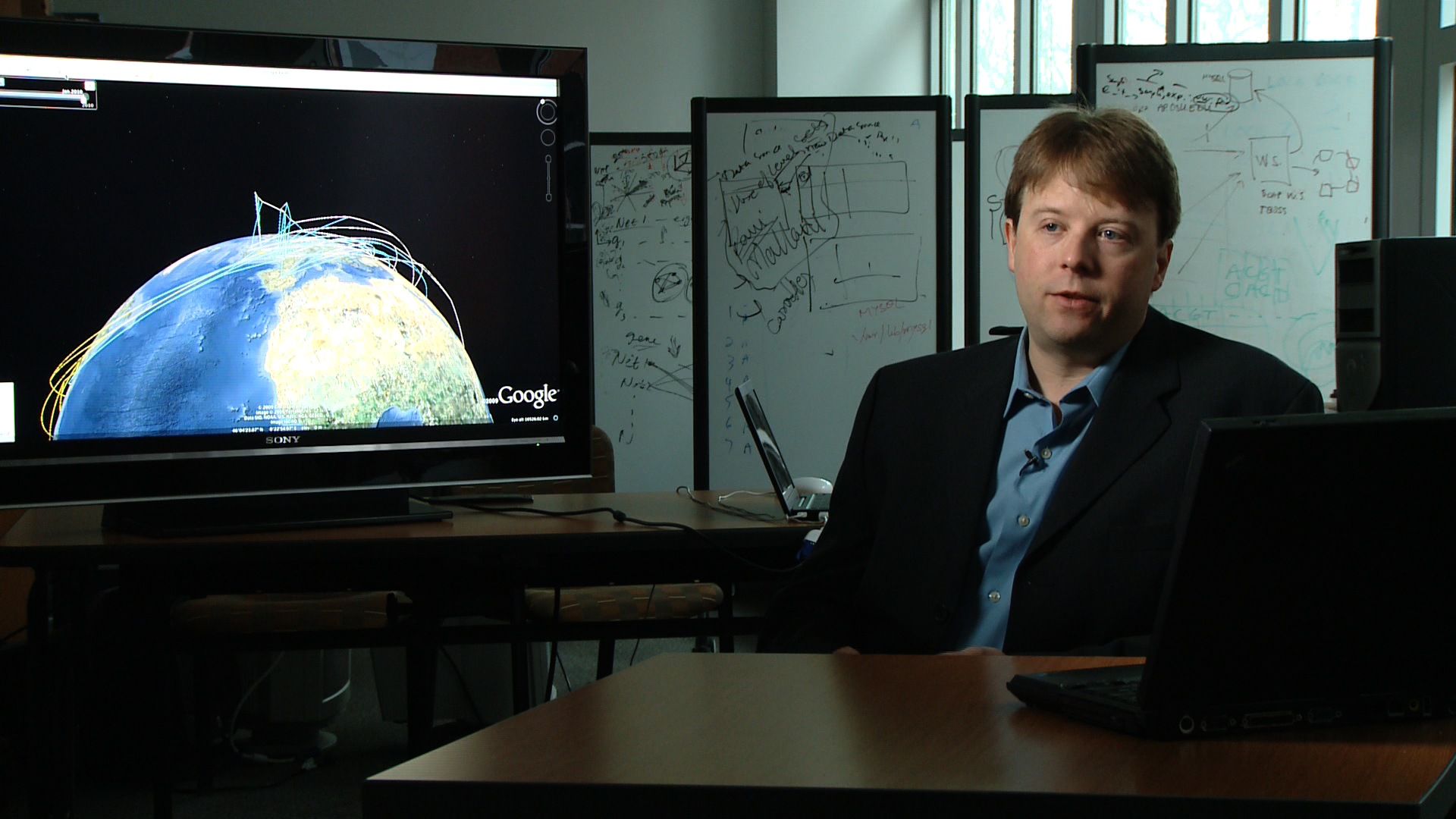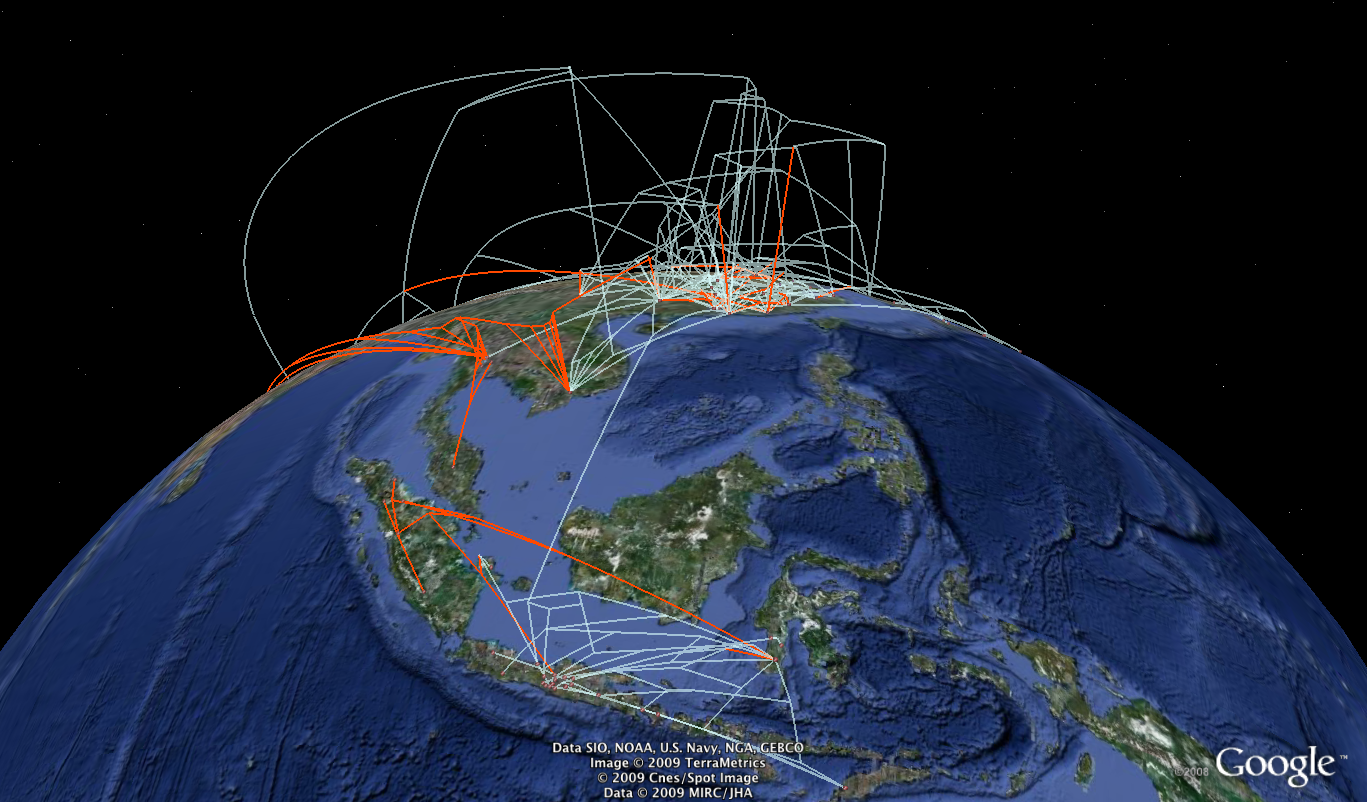A new web-based application powered by supercomputers has the potential to inform public health decisions by visualizing genetic and evolutionary information about the spread of infectious diseases across time, geography, host animals and humans.
 |
OSU biomedical informatics researcher Dan Janies describes the Supramap application he and his colleagues developed to monitor the spread of infectious diseases across time, geography and hosts. |
In a journal article published in the April 2010 online issue of Cladistics, Daniel Janies, Ph.D., explains how Supramap (http://supramap.osu.edu) was created to track the avian influenza virus (H5N1) and, more recently, to monitor the H1N1 virus. Cladistics refers to the scientific classification of living organisms, based on common ancestry, into evolutionary trees. Evolutionary trees are used by many researchers studying infectious diseases to understand the geographic and host origins of pathogens and how the pathogens change over time. Supramap puts phylogenies in a geographic context as well.
“The integration of our core phylogenetic reconstruction codes with Supramap has allowed an entirely new way to view linked evolutionary and geographic information,” said Ward Wheeler, a coauthor of the article and curator-in-charge of scientific computing at the American Museum of Natural History (AMNH). “The Supramap tool set has broad utility not only in tracking human disease in time and space, but historical patters of biodiversity and global biotic changes.”
Janies, an associate professor of Biomedical Informatics at The Ohio State University (OSU), Wheeler and several colleagues created Supramap to calculate and project evolutionary trees in online geographic information systems, such as Google Earth. The resulting visualizations have been described as “weather maps for disease” that allow public health officials to see when and where pathogens spread, jump from animals to humans and evolve to resist drugs.
“Currently, we are investigating H1N1 cases from around the world – and Ohio – by building evolutionary trees that discover how this strain came to be assembled and jumped from animals to humans. We are also monitoring specific viral genes for mutations that confer resistance to drugs” said Janies, an expert in computational genomics. “Using parallel programming on high performance computing systems at the Ohio Supercomputer Center (OSC) greatly improves the efficiency and accuracy of our work.”
Janies and his colleagues used a small cluster computer at OSU to beta-test the Supramap application, which has been developed through a grant from the Defense Advanced Research Projects Agency (DARPA). The research team also adapted the Supramap code to function smoothly on the OSC’s flagship IBM Cluster 1350 “Glenn” system, which features 9,500 cores and 24 terabytes of memory. They now are working with the Center’s staff to finish development of a Web interface to provide easy Internet access to the application by scientists and public health officials.
“OSC is at the forefront of emerging computational methods and their use by the next generation of health care researchers and providers – researchers like Dr. Janies,” said Ashok Krishnamurthy, interim co-executive director of OSC. “The use of high performance computing to help bring research results to community-accessible points-of-care will contribute significantly to the health and well being of people here and abroad.”
 |
|
Supramap uses Ohio Supercomputer Center resources and online geographic information systems, such as Google Earth, to calculate and project “weather maps for disease.”
|
Janies’ vision for Supramap involves receiving a steady stream of genomic and geographic data on pathogens from sources around the planet, analyzing the raw data nightly and updating maps available to public health officials each morning. Policymakers, he believes, could then make better-informed decisions on crucial issues, such as determining global hotspots for the emergence of dangerous pathogens and identifying where and when antiviral drugs are useful or not.
Janies was formally trained as a biologist, but as a result of the computational demands of the biological questions he was investigating, he began developing hardware and software. Janies led the design, construction, of a computing cluster during a previous post with AMNH. He earned his doctorate in zoology at the University of Florida and his bachelor’s degree in biology at the University of Michigan.
Wheeler’s research focuses on the systematic relationships among and within insects, crustaceans, and chelicerates, sequencing DNA and reconstructing evolutionary trees to study their evolution over 500 million years. To analyze those data, he has built some of the largest computing clusters in the world used for phylogenetic research. Wheeler earned his doctorate in zoology at Harvard University and his bachelor’s degree in biology at Yale College.
The article can be found online at: http://www3.interscience.wiley.com/journal/123345005/abstract
This material is based upon work supported by, or in part by, the U.S. Army Research Laboratory and Office under grant number W911NF-05-1-0271.
Full list of authors of the article, “The Supramap project: Linking pathogen genomes with geography to fight emergent infectious diseases.”
- Daniel Janies, The Ohio State University, Biomedical Informatics
- Travis Treseder, The Ohio State University, Biomedical Informatics
- Boyan Alexandrov, The Ohio State University, Biomedical Informatics
- Farhat Habib, Indian Institute of Science Education and Research
- Jennifer Chen, The Ohio State University, Biomedical Informatics
- Renato Ferreira, Universidade Federal de Minas Gerais, Brazil, Departamento de Ciência da Computação
- Ümit Catalyürek, The Ohio State University, Biomedical Informatics
- Andrés Varón, American Museum of Natural History, Division of Invertebrate Zoology
- Ward Wheeler, American Museum of Natural History, Department of Invertebrates
For more on Dr. Janies at the OSU Department of Biomedical Informatics, visit http://biomed.osu.edu/bmi/directory/faculty/janies/index.cfm.
For more on Dr. Wheeler at the American Museum of Natural History, visit http://research.amnh.org/scicomp/ward_wheeler.html.
____________
The Ohio Supercomputer Center is a catalytic partner of Ohio universities and industries that provides a reliable high performance computing infrastructure for a diverse statewide/regional community. OSC promotes and stimulates computational research and education in order to act as a key enabler for the state's aspirations in advanced technology, information systems, and advanced industries. For additional information, visit http://www.osc.edu